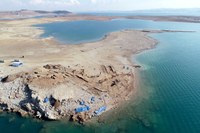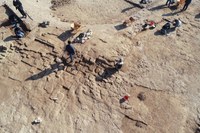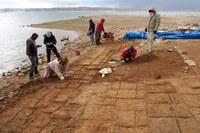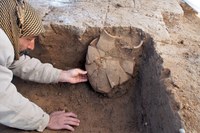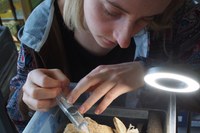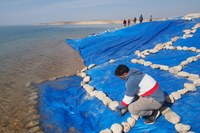A 3400-year-old city emerges from the Tigris River
Freiburg, May 30, 2022
A team of German and Kurdish archaeologists have uncovered a 3400-year-old Mittani Empire-era city once located on the Tigris River. The settlement emerged from the waters of the Mosul reservoir early this year as water levels fell rapidly due to extreme drought in Iraq. The extensive city with a palace and several large buildings could be ancient Zakhiku – believed to have been an important center in the Mittani Empire (ca. 1550-1350 BC).
Bronze Age city resurfaced due to drought
Iraq is one of the countries in the world most affected by climate change. The south of the country in particular has been suffering from extreme drought for months. To prevent crops from drying out, large amounts of water have been drawn down from the Mosul reservoir – Iraq's most important water storage – since December. This led to the reappearance of a Bronze Age city that had been submerged decades ago without any prior archaeological investigations. It is located at Kemune in the Kurdistan Region of Iraq.
This unforeseen event put archaeologists under sudden pressure to excavate and document at least parts of this large, important city as quickly as possible before it was resubmerged. The Kurdish archaeologist Dr. Hasan Ahmed Qasim, chairman of the Kurdistan Archaeology Organization, and the German archaeologists Jun.-Prof. Dr. Ivana Puljiz, University of Freiburg, and Prof. Dr. Peter Pfälzner, University of Tübingen, spontaneously decided to undertake joint rescue excavations at Kemune. These took place in January and February 2022 in collaboration with the Directorate of Antiquities and Heritage in Duhok (Kurdistan Region of Iraq).
Fritz Thyssen Foundation supported excavations
A team for the rescue excavations was put together within days. Funding for the work was obtained at short notice from the Fritz Thyssen Foundation through the University of Freiburg. The German-Kurdish archaeological team was under immense time pressure because it was not clear when the water in the reservoir would rise again.
Massive fortification, multi-storey storage building, industrial complex
Within a short time, the researchers succeeded in largely mapping the city. In addition to a palace, which had already been documented during a short campaign in 2018, several other large buildings were uncovered – a massive fortification with wall and towers, a monumental, multi-storey storage building and an industrial complex. The extensive urban complex dates to the time of the Empire of Mittani (approx. 1550-1350 BC), which controlled large parts of northern Mesopotamia and Syria.
"The huge magazine building is of particular importance because enormous quantities of goods must have been stored in it, probably brought from all over the region," says Puljiz. Qasim concludes, "The excavation results show that the site was an important center in the Mittani Empire."
The research team was stunned by the well-preserved state of the walls – sometimes to a height of several meters – despite the fact that the walls are made of sun-dried mud bricks and were under water for more than 40 years. This good preservation is due to the fact that the city was destroyed in an earthquake around 1350 BC, during which the collapsing upper parts of the walls buried the buildings.
Ceramic vessels with over 100 cuneiform tablets
Of particular interest is the discovery of five ceramic vessels that contained an archive of over 100 cuneiform tablets. They date to the Middle Assyrian period, shortly after the earthquake disaster struck the city. Some clay tablets, which may be letters, are even still in their clay envelopes. The researchers hope this discovery will provide important information about the end of the Mittani-period city and the beginning of Assyrian rule in the region. "It is close to a miracle that cuneiform tablets made of unfired clay survived so many decades under water," Pfälzner says.
Conservation project to prevent damage by rising water
To avert further damage to the important site by the rising water, the excavated buildings were completely covered with tight-fitting plastic sheeting and covered with gravel fill as part of an extensive conservation project funded by the Gerda Henkel Foundation. This is intended to protect the walls of unbaked clay and any other finds still hidden in the ruins during times of flooding. The site is now once more completely submerged.
Pressphoto for Download:
Contact:
Jun.-Prof. Dr. Ivana Puljiz
Institute for Archaeological Sciences
Department of Near Eastern Archaeology and Assyriology
University of Freiburg
Phone: +49 761 203 3143
E-mail: ivana.puljiz@orient.uni-freiburg.de
Dr. Hasan A. Qasim
Kurdistan Archaeology Organization
Kurdistan Region of Iraq
Phone: +964 750 4586702
E-Mail: hassan_5618@yahoo.com
Prof. Dr. Peter Pfälzner
Institute for Ancient Near Eastern Studies (IANES)
Near Eastern Archaeology
University of Tübingen
Phone: +49 7071 29 78530
E-Mail: peter.pfaelzner@uni-tuebingen.de
Annette Kollefrath-Persch
Office of University and Science Communications
University of Freiburg
Phone: +49 761 / 203-8909
E-Mail: annette.persch@zv.uni-freiburg.de


